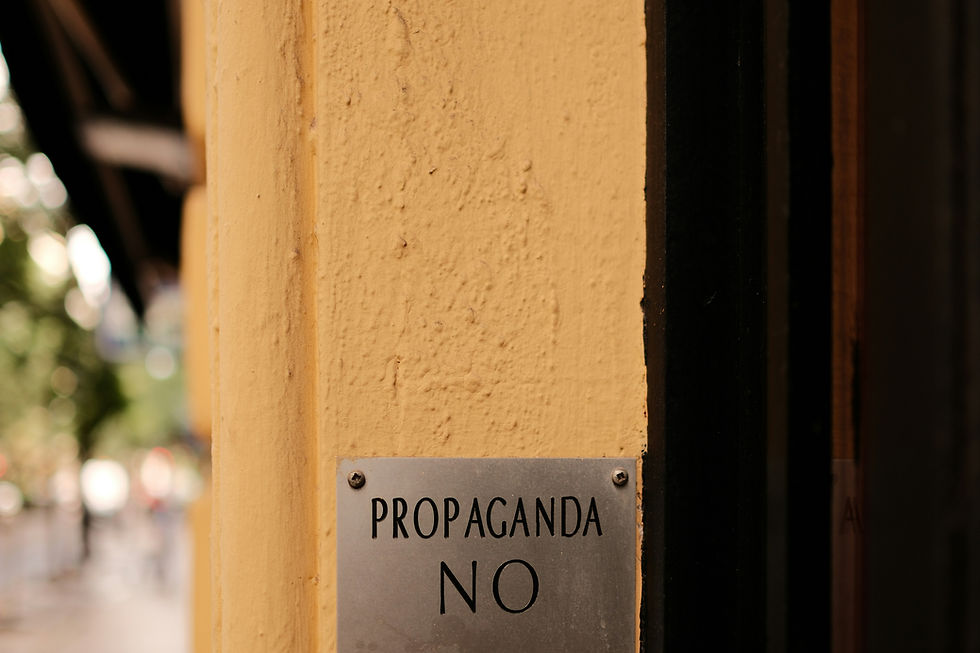Ukraine’s War of Fact and Fiction
- Res Publica

- Oct 23
- 4 min read
Getting accurate information and news is harder than ever in the social media age, but close to existential in a country at war.

As with much of the world, traditional Ukrainian outlets like television, newspapers, and radio play a diminishing role. Citizens have increasingly turned instead to Telegram, YouTube, and Facebook, even though trust in these digital platforms is strikingly low.
A survey of 2,000 Ukrainians by Rating Group, a Kyiv-based research organization, highlights the paradox of people using information sources they do not fully believe. With good reason — the Russian propaganda machine works hard to exploit such channels with morale-sapping untruth, while the Kyiv government has to maintain resilience without sliding into excessive state control.
The survey, commissioned by the Lviv Media Forum and International Media Support, shows that Telegram has become the dominant news platform in Ukraine, with more than half of those interviewed using it frequently. YouTube and Facebook follow, while the state-run United News TV channel is a regular source for only a quarter of citizens. Traditional newspapers, radio, and regional news outlets barely register.
Despite choosing to use these social media channels, only 29% said they trust what they see on Telegram, and just 24% trust YouTube. The government’s flagship United News telemarathon, meanwhile, draws the highest levels of distrust, with nearly 40% saying they do not believe what it broadcasts.
Ukrainians’ reliance on platforms they distrust opens a gap between news consumption and confidence, a space where lies and half-truths can thrive — especially when nearly 40% say they never verify the accuracy of news and only 18% say they always do. Even then, verification practices are weak. Most interviewees said they rely on their own “intuition” rather than cross-checking with other credible sources.
The most vulnerable groups identified by the survey were those in frontline regions, poorer and less-educated populations, and Russian-speaking or bilingual citizens. And, alarmingly, those groups rated their ability to distinguish truth from falsehood as highly as more resilient people (those who seek to verify information from trustworthy sources), suggesting a dangerous overconfidence.
Almost half of Ukrainians describe disinformation as “a major challenge,” which shows they are aware of the problem even though the tools they use to confront it are inadequate.
The Ukrainian government’s response has been to centralize communications. Since the early weeks of the full-scale invasion, the United News telemarathon has consolidated major television networks into a single, state-directed broadcast, which officials argue is necessary to deliver coherent messaging during wartime.
With one dominant voice on television, many citizens turn elsewhere, which drives citizens toward less trustworthy platforms and so creates fertile ground for propaganda.
These domestic challenges interlock with Moscow’s propaganda campaigns. These follow a well-rehearsed pattern of false stories appearing on obscure websites, which are then circulated through smaller Telegram channels, before amplification by major accounts and larger outlets. Once translated into English, these narratives spread internationally, gaining legitimacy and reach.
Social media platforms such as Facebook, Twitter/X, and YouTube remain central to this system, and Russian operatives deploy bots and troll networks to flood platforms with coordinated content. Bots often emerge in waves around major geopolitical events, such as the start of Russia’s full-scale invasion, ensuring propaganda adapts to developments in real time.
Russia also exploits advertising algorithms to reach audiences. By segmenting populations and targeting messages to more receptive groups, propagandists are able to make their content more effective. And, rather than relying on outright falsehoods, they often use emotionally charged narratives to polarize societies.
Moscow also backs pseudo-independent outlets that masquerade as legitimate media as part of a coordinated Kremlin strategy. The Czech government imposed sanctions on Voice of Europe, a channel bankrolled by exiled Ukrainian oligarch Viktor Medvedchuk, for example, for spreading Russian propaganda ahead of the European Parliament elections.
Remarkably, Ukraine stands out among its neighbors when it comes to resisting Moscow’s propaganda. According to the Disinformation Resilience Index 2024, it ranks as the most resilient country among 10 in Central and Eastern Europe, including Poland, Hungary, Slovakia, and the states of the South Caucasus.
Societal mobilization as a result of the war has hardened public resistance to Kremlin narratives, yet this resilience remains fragile. While trust in Russian media has collapsed, distrust of domestic sources has grown, suggesting Ukraine’s resilience is driven by crisis rather than institutional stability — a national struggle for survival rather than a sustainable media ecosystem.
This creates a dilemma as Ukraine’s media is squeezed between the need for centralized strategic communication in wartime, even as the risk of overreach erodes pluralism and credibility.
If the state monopolizes information, it may undermine the very trust it seeks to preserve. But if it leaves information flows too open, Russia can exploit the vacuum. Balancing these pressures is essential not only for Ukraine’s democracy but for sustaining the information front in the war.
Transparency in state communication, including reforms to the telemarathon, would help rebuild trust and avoid perceptions of monopolization. At the same time, international monitoring and exposure of Russian influence operations — from bot networks to pseudo-media like Voice of Europe — is vital to blunt their impact and reduce their influence on democratic processes.
As the war drags on, the challenge will be to preserve freedom and pluralism while maintaining effective strategic communication. For Ukraine, and for its partners, the battle for truth is now inseparable from the battle for sovereignty.
By Kateryna Odarchenko. Kateryna Odarchenko is a political consultant, a partner of the SIC Group Ukraine, and president of the PolitA Institute for Democracy and Development. A specialist practicing in the field of political communication and projects, she has practical experience in the implementation of all-Ukrainian political campaigns and party-building projects. Article first time published on CEPA web page. Prepared for publication by volunteers from the Res Publica - The Center for Civil Resistance.





Comments